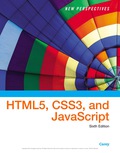
EBK NEW PERSPECTIVES ON HTML5, CSS3, AN
6th Edition
ISBN: 9781337516358
Author: Carey
Publisher: CENGAGE LEARNING - CONSIGNMENT
expand_more
expand_more
format_list_bulleted
Concept explainers
Question
Chapter 12, Problem 2CP2
Program Plan Intro
To link the sub_cart.js file by using the script element tag in file sub_menu.html asynchronously and to study and describe the content and structure of file sub_menu.html.
Expert Solution & Answer
Want to see the full answer?
Check out a sample textbook solution
Students have asked these similar questions
"Do not use AI tools. Solve the problem by hand on paper only and upload a photo of your handwritten solution."
"Do not use AI tools. Solve the problem by hand on paper only and upload a photo of your handwritten solution."
"Do not use AI tools. Solve the problem by hand on paper only and upload a photo of your handwritten solution."
Chapter 12 Solutions
EBK NEW PERSPECTIVES ON HTML5, CSS3, AN
Ch. 12.2 - Prob. 1QCCh. 12.2 - Prob. 2QCCh. 12.2 - Prob. 3QCCh. 12.2 - Prob. 4QCCh. 12.2 - Prob. 5QCCh. 12.2 - Prob. 6QCCh. 12.3 - Prob. 1QCCh. 12.3 - Prob. 2QCCh. 12 - Prob. 1RACh. 12 - Prob. 2RA
Ch. 12 - Prob. 3RACh. 12 - Prob. 4RACh. 12 - Prob. 5RACh. 12 - Prob. 6RACh. 12 - Prob. 7RACh. 12 - Prob. 8RACh. 12 - Prob. 9RACh. 12 - Prob. 10RACh. 12 - Prob. 11RACh. 12 - Prob. 12RACh. 12 - Prob. 13RACh. 12 - Prob. 1CP1Ch. 12 - Prob. 2CP2Ch. 12 - Prob. 3CP2Ch. 12 - Prob. 4CP2Ch. 12 - Prob. 5CP2Ch. 12 - Prob. 4CP3Ch. 12 - Prob. 20CP3Ch. 12 - Prob. 3CP4Ch. 12 - Prob. 4CP4Ch. 12 - Prob. 5CP4Ch. 12 - Prob. 6CP4Ch. 12 - Prob. 7CP4Ch. 12 - Prob. 8CP4Ch. 12 - Prob. 9CP4Ch. 12 - Prob. 10CP4Ch. 12 - Prob. 11CP4Ch. 12 - Prob. 12CP4Ch. 12 - Prob. 13CP4Ch. 12 - Prob. 14CP4
Knowledge Booster
Learn more about
Need a deep-dive on the concept behind this application? Look no further. Learn more about this topic, computer-science and related others by exploring similar questions and additional content below.Similar questions
- "Do not use AI tools. Solve the problem by hand on paper only and upload a photo of your handwritten solution."arrow_forwardSolve this "Do not use AI tools. Solve the problem by hand on paper only and upload a photo of your handwritten solution."arrow_forward"Do not use AI tools. Solve the problem by hand on paper only and upload a photo of your handwritten solution."arrow_forward
- "Do not use AI tools. Solve the problem by hand on paper only and upload a photo of your handwritten solution."arrow_forwardSpecifications: Part-1Part-1: DescriptionIn this part of the lab you will build a single operation ALU. This ALU will implement a bitwise left rotation. Forthis lab assignment you are not allowed to use Digital's Arithmetic components.IF YOU ARE FOUND USING THEM, YOU WILL RECEIVE A ZERO FOR LAB2!The ALU you will be implementing consists of two 4-bit inputs (named inA and inB) and one 4-bit output (named out). Your ALU must rotate the bits in inA by the amount given by inB (i.e. 0-15).Part-1: User InterfaceYou are provided an interface file lab2_part1.dig; start Part-1 from this file.NOTE: You are not permitted to edit the content inside the dotted lines rectangle. Part-1: ExampleIn the figure above, the input values that we have selected to test are inA = {inA_3, inA_2, inA_1, inA_0} = {0, 1, 0,0} and inB = {inB_3, inB_2, inB_1, inB_0} = {0, 0, 1, 0}. Therefore, we must rotate the bus 0100 bitwise left by00102, or 2 in base 10, to get {0, 0, 0, 1}. Please note that a rotation left is…arrow_forwardSolve this "Do not use AI tools. Solve the problem by hand on paper only and upload a photo of your handwritten solution."arrow_forward
- Solve this "Do not use AI tools. Solve the problem by hand on paper only and upload a photo of your handwritten solution."arrow_forward"Do not use AI tools. Solve the problem by hand on paper only and upload a photo of your handwritten solution."arrow_forwardSolve this "Do not use AI tools. Solve the problem by hand on paper only and upload a photo of your handwritten solution."arrow_forward
- Solve this "Do not use AI tools. Solve the problem by hand on paper only and upload a photo of your handwritten solution."arrow_forwardSpecifications: Part-2Part-2: DescriptionIn this part of the lab, we will illuminate two 7-segment displays. You will need to understand 2's Complement todetermine when the input 4-bit binary number corresponds to a negative or positive number. To understand how anLED display works in Digital, please refer to the playWithLED_Display.dig file provided. You should play withdifferent input combinations to see how it influences the LED Display value. In the screenshot below, note how I wasable to generate the display of “3” on the Hex display by lighting up only certain input wires to the unit. Here is a picture of how the different segments light up to produce the different displays: Note in the picture above that we showed displays only from 0-8 since in 4-bit 2s complement representation, 8 is thelargest modulus value you can represent (the range of integers would be -8 to +7).Your circuit in Part-2 must accept a 4-bit 2's complement input {in3, in2, in1, in0} where in3 is the most…arrow_forwardSolve this "Do not use AI tools. Solve the problem by hand on paper only and upload a photo of your handwritten solution."arrow_forward
arrow_back_ios
SEE MORE QUESTIONS
arrow_forward_ios
Recommended textbooks for you
 New Perspectives on HTML5, CSS3, and JavaScriptComputer ScienceISBN:9781305503922Author:Patrick M. CareyPublisher:Cengage Learning
New Perspectives on HTML5, CSS3, and JavaScriptComputer ScienceISBN:9781305503922Author:Patrick M. CareyPublisher:Cengage Learning

New Perspectives on HTML5, CSS3, and JavaScript
Computer Science
ISBN:9781305503922
Author:Patrick M. Carey
Publisher:Cengage Learning